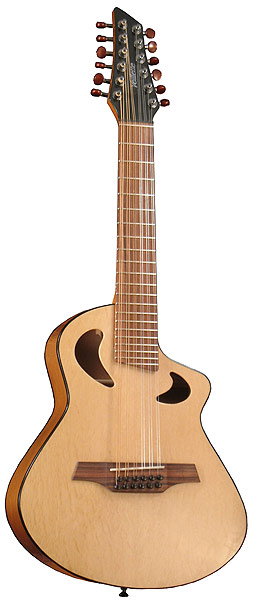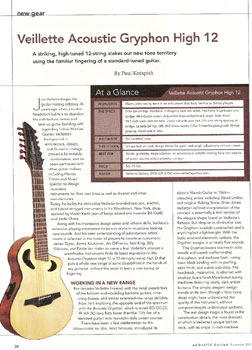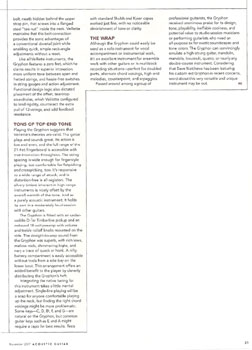
|
Articles
Today, he builds his distinctive Veillette-branded acoustic, electric, and hybrid stringed instruments in his Woodstock, New York, shop assisted by Martin Keith (son of banjo wizard and inventor Bill Keith) and Ande Chase. Along with his impressive design sense and lutherie skills, Veillette's extensive playing experience helps him relate to musicians seeking new sounds. And his keen understanding of adventurous artists' needs is reflected in the roster of players he counts as customers: James Taylor, Jorma Kaukonen, Ani DiFranco, Kaki King, Billy Gibbons, and Eddie Van Halen to name a few. Veillette's interest in unorthodox instruments finds its latest expression in the Acoustic Gryphon High 12, a 12-string tuned to high D that puts a whole new range of sonic possibilities in the hands of any guitarist, without the need to learn a new tuning or fingering.
WORKING IN A NEW RANGE There have been a few predecessors to this idiosyncratic ax. Vox, most famously, introduced its electric Mando Guitar in 1964attracting artists including David Lindley and original Rolling Stone, Brian Jones. Veillette's refined interpretation of the concept is essentially a mini version of the elegant shape found on Veillette's flattops. But despite its diminutive size, the Gryphon is solidly constructed and is anything but a lightweight. With the basic onboard electronic options, the Gryphon weighs in at nearly five pounds. The Gryphon boasts top-notch solid woods and superb craftsmanship throughout, and eschews flash-using basic black binding with no purfling, satin finish, and subtle side dots. The headstock, meanwhile, is adorned with smoked, black-finish Mini-Gotoh tuning machines featuring lovely, dark amber buttons. The simple, elegant design stands on its own, though a little more detail might have underscored the quality of the instrument without compromising its understated aesthetic.
At a Glance
The real design magic is found in the construction details, the most dramatic of which is Veillette's unique bolt-on neck, with its single ¼-inch machine
bolt, neatly hidden behind the upper strap pin, that screws into a flanged steel "tee-nut" inside the neck. Veillette maintains that this bolt connection provides the sonic advantages of
a conventional dovetail joint while enabling quick, simple neck-angle adjustments without a reset.
HIGHLIGHTS
THE SPECS
WATCH FOR
THIS IS COOL
BEST FOR
PRICE Like all Veillette instruments, the Gryphon features a zero fret, which he claims results in superior intonation, more uniform tone between open and fretted strings, and hassle-free switches in string gauges and action adjustment. Functional design logic also dictated placement of the offset, teardrop soundholes, which Veillette configured to lend rigidity, counteract the extra pull of 12-strings, and add feedback resistance.
TONS OF TOP-END TONE The Gryphon is fitted with an undersaddle D-Tar Timberline pickup and an onboard 18-volt preamp with volume and treble rolloff knobs mounted on the side. The straight-to-amp sound from the Gryphon was superb, with rich lows, mellow mids, shimmering highs, and nary a trace of quack or honk. A nifty battery compartment is easily accessible without tools from a side bay on the lower bout. This arrangement offers an added benefit to the player by cleverly distributing the Gryphon's heft. Integrating the native tuning for this instrument takes a little mental adjustment. Single-line playing will be a snap for anyone comfortable playing up the neck, but finding the right chord voicings might be more problematic. Some keys-C, D, B flat, F, and G-are natural on the Gryphon, but common guitar keys such as E and A might require a capo for best results. Tests with standard Shubb and Kyser capos worked just fine, with no noticeable diminishment of tone or clarity.
THE WRAP Passed around among a group of professional guitarists, the Gryphon received unanimous praise for its design, tone, playability, ineffable coolness, and potential value to studio-session musicians or performing guitarists who need an all-purpose ax for exotic soundscapes and tone colors. The Gryphon can convincingly emulate a high-strung guitar, mandolin, mandola, bouzouki, quatro, or nearly any double-course instrument. Considering that Dave Matthews has been featuring his custom red Gryphon in recent concerts, word about this very versatile and unique instrument may be out.
|
| © Veillette Guitars SEARCH OUR SITE |
 Veillette Acoustic Gryphon High 12
Veillette Acoustic Gryphon High 12 Joe Veillette began his guitar-making odyssey 36 years ago when a broken headstock led him to abandon his architecture career and
take up guitar building with legendary luthier Michael Gurian. Veillette's background in architecture, design, and Gurian's tutelage
proved a formidable combination, and he soon partnered with
other guitar makers,
including Harvey
Citron and Stuart
Spector to design
innovative
instruments for their own lines as well as Alvarez and other manufacturers.
Joe Veillette began his guitar-making odyssey 36 years ago when a broken headstock led him to abandon his architecture career and
take up guitar building with legendary luthier Michael Gurian. Veillette's background in architecture, design, and Gurian's tutelage
proved a formidable combination, and he soon partnered with
other guitar makers,
including Harvey
Citron and Stuart
Spector to design
innovative
instruments for their own lines as well as Alvarez and other manufacturers.

